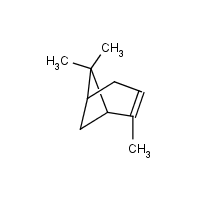alpha-Pinene
Agent Name
alpha-Pinene
CAS Number
80-56-8
Formula
C10-H16
Major Category
Biological Agents

Synonyms
2,6,6-Trimethylbicyclo(3.1.1)-2-hept-2-ene; 2,6,6-Trimethylbicyclo(3.1.1)hept-2-ene; 2-Pinene; 4,6,6-Trimethylbicyklo(3,1,1)hept-3-en [Czech]; Acintene A; Bicyclo(3.1.1)hept-2-ene, 2,6,6-trimethyl; Monoterpenes; PINENE, ALPHA; Pinene isomer; alpha-Pinene (natural); [ChemIDplus] UN2368
Category
Terpenes
Description
Colorless liquid with an odor of turpentine; [HSDB]
Sources/Uses
Used to make camphor, insecticides, solvents, plasticizers, perfume bases, synthetic pine oil, flavorings, geraniol, terpineol, terpene esters and ethers, lube oil additives, camphene, terpin hydrate, and toxaphene; Also used as an odorant for synthetic resins and as a solvent for protective coatings, polishes, and waxes; [HSDB]
Comments
"Turpentine and the monoterpenes (alpha-pinene, beta-pinene, 3-carene) are skin and mucous membrane irritants, and in high concentrations, are central nervous system (CNS) depressants." A dermal sensitizer; [ACGIH] A skin, eye, and mucous membrane irritant; Toxic by ingestion with effects similar to turpentine poisoning; Mean lethal oral dose for adult = 4-6 oz; Potential health effects include CNS depression and kidney damage; [HSDB] Harmful by inhalation, ingestion, and skin absorption; [CAMEO] An irritant; May cause skin sensitization; [MSDSonline] See "Turpentine." See "TERPENES."
Biomedical References
Exposure Assessment
Skin Designation (ACGIH)
No
TLV (ACGIH)
20 ppm
MAK
5 ppm
Vapor Pressure
4.75 mm Hg
Lethal Concentration
LCLo (rat) = 0.625 mg/m3
Explanatory Notes
Flash point = 33 deg C; [HSDB] VP from ChemIDplus;
NFPA
may ignite at ambient temp
Adverse Effects
Skin Sensitizer
Yes
Neurotoxin
Acute solvent syndrome
Nephrotoxin
Yes
ACGIH Carcinogen
Not Classifiable
Diseases, Processes, and Activities Linked to This Agent
Diseases
Occupational diseases associated with exposure to this agent:
Processes
Industrial Processes with risk of exposure: